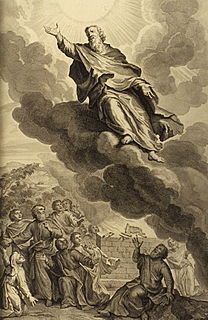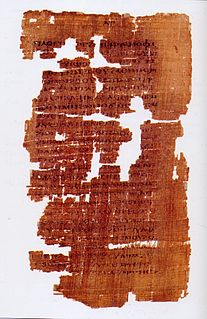Related Research Articles

Apocrypha are the biblical books received by the early Church as part of the Greek version of the Old Testament, but not included in the modern Hebrew Bible. They were excluded from their canon by the non-Hellenistic Jews, centuries after the Christian scriptures were compiled. Their position in Christian usage has been ambiguous.

The Bible is a collection of religious texts or scriptures sacred in Christianity, Judaism, Samaritanism, and many other faiths. It appears in the form of an anthology, a compilation of texts of a variety of forms, originally written in Hebrew, Aramaic, and Koine Greek. These texts include instructions, stories, poetry, and prophesies, among other genres. The collection of materials that are accepted as part of the Bible by a particular religious tradition or community is called a biblical canon. Believers generally consider the Bible to be a product of divine inspiration while understanding what that means in different ways.

Isaac is one of the three patriarchs of the Israelites and is an important figure in the Abrahamic religions, including Judaism, Christianity, and Islam. He was the son of Abraham and Sarah, the father of Jacob, and the grandfather of the twelve tribes of Israel.

The Old Testament is the first division of the Christian biblical canon, which is based primarily upon the 24 books of the Hebrew Bible or Tanakh, a collection of ancient religious Hebrew writings by the Israelites. The second division of Christian Bibles is the New Testament, written in the Koine Greek language.

Nikephoros I or Nicephorus I was a Christian Byzantine writer and Ecumenical Patriarch of Constantinople from 12 April 806 to 13 March 815.

Enoch is a biblical figure and patriarch prior to Noah's flood and the son of Jared and father of Methuselah. He was of the Antediluvian period in the Hebrew Bible.

The highest-ranking bishops in Eastern Orthodoxy, Oriental Orthodoxy, the Catholic Church, the Hussite Church, and the Church of the East are termed patriarchs.

Levi was, according to the Book of Genesis, the third of the six sons of Jacob and Leah, and the founder of the Israelite Tribe of Levi and the great-grandfather of Aaron, Moses and Miriam. Certain religious and political functions were reserved for the Levites.

According to the Book of Genesis, Naphtali was the last of the two sons of Jacob and Bilhah. He was the founder of the Israelite Tribe of Naphtali.

The Pauline epistles, also known as Epistles of Paul or Letters of Paul, are the thirteen books of the New Testament attributed to Paul the Apostle, although the authorship of some is in dispute. Among these epistles are some of the earliest extant Christian documents. They provide an insight into the beliefs and controversies of early Christianity. As part of the canon of the New Testament, they are foundational texts for both Christian theology and ethics.

Pseudepigrapha are falsely attributed works, texts whose claimed author is not the true author, or a work whose real author attributed it to a figure of the past.
Mahalalel was a patriarch named in the Hebrew Bible. The King James Version spells his name Mahalaleel in the Old Testament and Maleleel in the New Testament.
The Book of the Bee is a historiographic and theological compilation, containing numerous Biblical stories. It was written around 1222, by Solomon of Akhlat, who was Bishop of Basra, within the Church of the East. It is written in Syriac language.

The New Testament apocrypha are a number of writings by early Christians that give accounts of Jesus and his teachings, the nature of God, or the teachings of his apostles and of their lives. Some of these writings have been cited as scripture by early Christians, but since the fifth century a widespread consensus has emerged limiting the New Testament to the 27 books of the modern canon. Roman Catholic, Eastern Orthodox, and Protestant churches generally do not view these New Testament apocrypha as part of the Bible.

The Codex Alexandrinus is a fifth-century Christian manuscript of a Greek Bible, containing the majority of the Greek Old Testament and the Greek New Testament. It is one of the four Great uncial codices. Along with the Codex Sinaiticus and the Vaticanus, it is one of the earliest and most complete manuscripts of the Bible. Brian Walton assigned Alexandrinus the capital Latin letter A in the Polyglot Bible of 1657. This designation was maintained when the system was standardized by Wettstein in 1751. Thus, Alexandrinus held the first position in the manuscript list.

The Testaments of the Twelve Patriarchs is a constituent of the apocryphal scriptures connected with the Bible. It is believed to be a pseudepigraphical work of the dying commands of the twelve sons of Jacob. It is part of the Oskan Armenian Orthodox Bible of 1666. Fragments of similar writings were found at Qumran, but opinions are divided as to whether these are the same texts. It is generally considered apocalyptic literature.
The Lost Books of the Bible and the Forgotten Books of Eden (1926) is a collection of 17th-century and 18th-century English translations of some Old Testament Pseudepigrapha and New Testament apocrypha, some of which were assembled in the 1820s, and then republished with the current title in 1926.
The Stichometry of Nicephorus is a stichometry by Patriarch Nicephorus I of Constantinople. It is significant in that it counts the number of lines of various Christian texts, many of which have been lost over the course of time. This has enabled modern scholars to determine how much of various fragmentary texts from the New Testament apocrypha and Old Testament apocrypha remain missing.

The First Epistle of Clement is a letter addressed to the Christians in the city of Corinth. Based on internal evidence some scholars say the letter was composed some time before AD 70, but the common time given for the epistle's composition is at the end of the reign of Domitian. It ranks with Didache as one of the earliest, if not the earliest, of extant Christian documents outside the traditional New Testament canon. As the name suggests, a Second Epistle of Clement is known, but this is a later work by a different author. Part of the Apostolic Fathers collection, 1 and 2 Clement are not usually considered to be part of the canonical New Testament.

Robert Henry Charles, was an Irish Anglican theologian, biblical scholar, professor, and translator from Northern Ireland. He is known particularly for his English translations of numerous apocryphal and pseudepigraphal Ancient Hebrew writings, including the Book of Jubilees (1895), the Apocalypse of Baruch (1896), the Ascension of Isaiah (1900), the Book of Enoch (1906), and the Testaments of the Twelve Patriarchs (1908), which have been widely used. He wrote the articles in the eleventh edition of Encyclopædia Britannica (1911) attributed to the initials "R. H. C."
References
- ↑ Chisholm, Hugh, ed. (1911). . Encyclopædia Britannica . Vol. 26 (11th ed.). Cambridge University Press. p. 666.